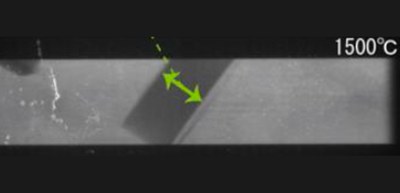
Successful measurements of sound speed of the Martian core will clarify the component of Martian core and the origin of Mars
A group of researchers from The University of Tokyo, Tohoku University, Osaka University, Tokyo Institute of Technology, the High Energy Accelerator Research Organization (KEK) Japan, and the Super Photon ring-8 GeV (SPring-8) of the Japan Synchrotron Radiation Research Institute (JASRI) has measured the sound velocity of liquid iron (Fe)-sulfur(S) alloy, which is thought to be a primary component of the Martian core, at 20 GPa and 2000 K.
Although it was thought that the Martian core was made up primarily of Fe-S alloy, the internal structure and composition of Mars is not well understood. In NASA's ongoing Interior Exploration using Seismic Investigations, Geodesy and Heat Transport (InSight) mission, a robotic lander designed to study the deep interior of Mars, a seismometer is placed on the surface of Mars. If seismic waves that travel through Mars’ core can be measured, their speed will be available.
This group of researchers measured the sound velocity (seismic wave speed) of liquid Fe-S alloys in experiments. High-pressure, high-temperature experiments using a Kawai-type multi-anvil apparatus, in combination with an ultrasonic pulse-echo overlap method and strong X-ray beams from the SPring-8 and KEK-PF synchrotron radiation facilities, allow for accurate measurements of sound speed; however, the measurements of sound speed using this method were made only up to 8 GPa.
By improving techniques for high-pressure experiments and ultrasonic measurements, this group measured the sound velocity of liquid Fe alloy up to 20 GPa, likely corresponding to the pressure at the uppermost core of Mars, and found that sulfur had little effect on the compressional sound velocity (VP) of liquid iron in the Mars’ whole core pressure range (~20 to ~40 GPa).
If the velocity of seismic waves in Mars core measured by InSight matches the values obtained in this study, the hypothesis that Martian core was made up primarily of Fe-S alloy will be verified. If it does not match, Mars’ origins should be reconsidered.
Giant collision with Earth is the likely origin of the Moon. If primitive Mars collided with planetesimals, Mars core may have other impurities. The mantle of Mars is made up primarily of silicon and oxygen. If Mars was melted due to collisions with planetesimals on a large scale, these elements would be incorporated into the Martian core as well.
The Japanese Aerospace Exploration Agency (JAXA) plans to launch of Martian Moons eXploration (MMX), a robotic space probe set, in the mid-2020s to survey one of the planet’s two moons: Phobos or Deimos. JAXA will try to determine whether these two moons were formed through Mars’ collisions, just like the origin of Earth’s moon, or whether they are planetesimals that were caught by Mars’ gravity and became satellites by examining samples collected from one of these Mars moons.
If the exploration of Mars’ core in the near future and the measurements of sound velocity of liquid iron-silicon-oxygen alloy in experiments are combined, it can be verified whether or not there are silicon and oxygen in Martian core and whether Mars was hit by an asteroid. If this group’s method is used for verifying early Mars’ giant collision, this group’s achievements, along with MMX mission, will contribute to the clarification of the formation of Mars.
Figure 1
Figure 2
The article, “Effect of sulfur on sound velocity of liquid iron under Martian core conditions” was published in Nature Communications at DOI: https://www.nature.com/articles/s41467-020-15755-2.
